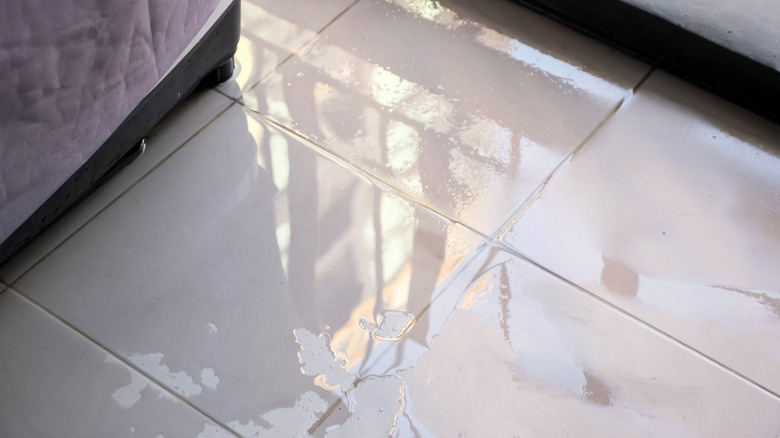If My Upstairs Bathroom Is Flooded, Is That Bad For The Ceiling?
When your upstairs bathroom is flooded, your ceiling is definitely at risk. Bathrooms may flood at any time, especially since they have multiple plumbing fixtures in them that can be the source of water spilling out onto the floor. If you cannot prevent a flood in your bathroom, you need to understand the potential damage to your house, including the ceiling below the bathroom.
Tip
Even minor flooding in your upstairs bathroom can do substantial damage to the ceiling below.
How to Stop the Flooding
How to Stop the Flooding
When your bathroom floor floods, the first thing to worry about is stopping the source of the flooding. If you concentrate on sopping up the water on the floor, the problem will just continue to grow. Generally in a bathroom, the sources of flooding are the toilet, sink, and shower/tub.
To stop the flooding:
- Close the overflowing plumbing fixture's water supply valves, if you know where they are located. (Toilets and sinks generally have their own shut-off valves that are easy to locate.)
- If you can't identify the source of the leak, or can't find its shut-off valve, close the main water valve for the house.
- With the water supply turned off, you need to then concentrate on getting as much of the water off the floor as quickly as possible before it finds a way into the subfloor.
Ceiling Damage and Repair
Ceiling Damage and Repair
Drywall doesn't necessarily need to be replaced after it gets wet. Your upstairs bathroom flood may be small enough to dampen the drywall without destroying it. You may notice a water stain on the ceiling after the drywall has dried out, but you can paint over the stain to restore the look of the ceiling. All that you need to do is clean the spot with bleach first and apply a stain-blocking primer before painting.
However, if the drywall becomes wet to the point that it starts to fall down or crack, or if mold starts to grow in it, you'll need to remove the damaged drywall and patch the hole in the ceiling. If the hole is large enough and the patch does not stay in place, place a backerboard on the other side of the ceiling so the patch has a surface to cling to. Consult a professional to ascertain the extent of the damage to your drywall.
Managing Subfloor Damage
Managing Subfloor Damage
Even if the ceiling is not badly damaged, water surely soaked a portion of the sub floor if the ceiling was wet. You may not see the damage in the subfloor, but it can still pose a serious problem. If the floor joists warp and weaken from the water or if mold grows from the water exposure, the floor may fail and fall into the room below.
Tip
Repairing damage to the bathroom's sub floor involves tearing up the flooring and is an extensive process, one for which you may want to hire a flooring company. If you decide to make the repairs yourself, wear a protective face mask and gloves since you may encounter mold growth.
Preventing Future Bathroom Floods
Preventing Future Bathroom Floods
Once you've survived one upstairs bathroom flood, you'll never want to go through it again. Use the experience to adopt new practices for preventing future floods.
For example, some homeowners do not think about the overflow drain in their sinks or bathtub until the sink or bathtub is almost overflowing. These drains may clog up with debris over time and must be cleared out. You can pour bleach down the overflow drains periodically to break up any clogs inside of them. If you are dealing with a clogged toilet, you should shut off the water supply valve so you cannot flush the toilet more than once before you eliminate the clog.
